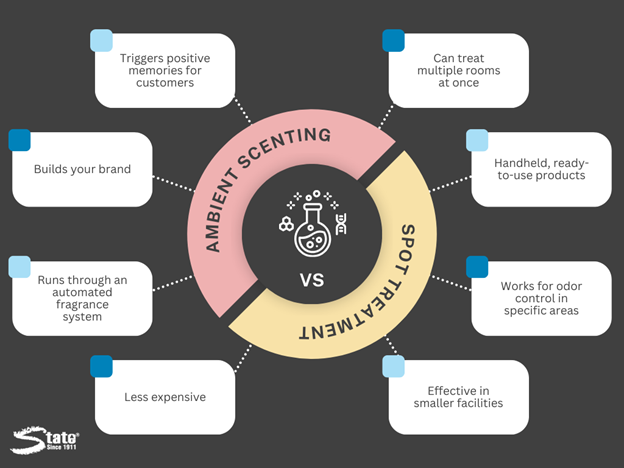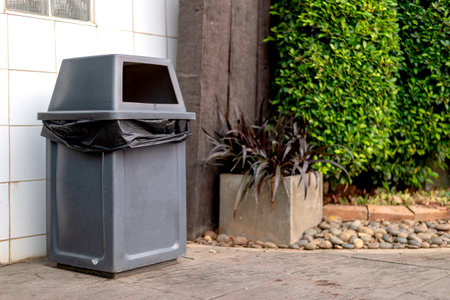Ambient Scenting vs. Odor Spot Treatment
Ambient Scenting vs. Odor Spot Treatment
When it comes down to your air care goals, you’re just trying to make your facility smell good. That’s your focus, and it should be simple, right?
The short answer is yes; it can be simple. But if you want the most effective solution for your situation, there are more factors to consider. For example, are you trying to simply control odors? Are you interested in building a brand fragrance? Do you have specific problem areas, or is it the larger facility? This is where the question of ambient scenting vs. spot treatment comes in.
At State Chemical, we manufacture and distribute ambient scenting solutions, like the State Fragrance Cube, as well as odor spot treatment, like Trade Winds. We know that you probably care less about how your problem is solved and more so about what product will solve it.
So, to help you pick the best product for your situation, we’re going to explain ambient scenting and spot treatment, and then we’re going to describe when you should use one option over the other. After reading, you’ll know what product category will best solve your problem and meet your goals.
What is Ambient Scenting?
First, it’s important to understand what ambient scenting and spot treatment are.
Ambient scenting is when an aroma is diffused throughout much or all of your facility through a fragrance system. This system is often located in a central area, like the lobby, outside the elevators, or even in the HVAC system.
With this setup, the system distributes a pleasant fragrance throughout the parts of your facility you choose, whether this is the entire facility or only the high-traffic areas. In this way, ambient scenting can control odors and add an aromatic scent to the facility as a whole.
What is Spot Treatment?
Meanwhile, spot treatment involves using a handheld product, like an aerosol, to manually treat a certain area in your facility. This could mean spraying down a room infamous for malodors, for example.

Spot treatment can be used to fragrance a space, but more often, it’s best used for odor control in a specific area. Constantly spraying an air freshener in a room will be a lot to consistently manage, but treating a trash can when it starts to smell, for example, is feasible. This is where spot treatment shines and where it may ultimately perform better.
Ambient Scenting Builds Your Brand
However, it’s again important to consider your goals. Because with ambient scenting, you have the opportunity to build brand recognition.
When your facility has a consistent fragrance, it becomes something that customers grow to expect and rely on. They associate that fragrance with your business, and when they then enter the building, they will catch onto a certain vibe.
And you get to choose what this vibe is.
Do you want your facility to come across as clean, neat, and organized? Would you prefer to give off a warm, cozy, welcoming aura? Perhaps you want your business to seem upscale, modern, and chic.
In any case, fragrance can be a part of shaping that, and ambient scenting ensures that this fragrance is consistent. With both consistency and the right mood set, your brand will have a clear-cut image in the eyes of customers.
Spot Treatment Works as Odor Control
As previously described, spot treatment functions effectively as odor control. While it can also be used to build your brand, it’s harder to do so consistently. Meanwhile, if you have specific problem areas, spot treatment may be more effective than ambient scenting.
For example, let’s imagine that you run a small bakery. You already have scents of fresh bread and warm pastries throughout your facility; you don’t want to use ambient scenting because it would interfere with the fragrances you already have. However, you have one glaring problem: the trash.
No matter how frequently you clean it out, it seems to have an odor. Here is where spot treatment takes center stage. By spraying the trash can down with an odor eliminator and/or fragrance, you can cover up the smells you don’t want while keeping the ones you do want. With ambient scenting, this just wouldn’t be possible.
Ambient Scenting Triggers Positive Memories for Customers
For facilities that don’t have the advantage of naturally good smells, ambient scenting can trigger positive memories as well as brand recognition.
Studies show that scents that evoke personal memories elicit twice as much nostalgia as music does. When you apply this science to your business, you have the potential to create more positive customer associations. If your business smells nice and gives customers a positive experience, they are more likely to return.
Spot Treatment Can be More Effective in Smaller Facilities
When treating smaller facilities, it can be more cost-effective to use spot treatment rather than ambient scenting. Rather than investing in a large, expensive system, you can usually use spot treatment consistently enough to create an ambience.
This will entail consistently remembering to use your product since it won’t be on an automated system. But if you can do that, you can save money while still having feasible, easy-to-use odor control.
Ambient Scenting Can Treat Multiple Rooms at Once
Ambient scenting makes more sense to use if you have multiple rooms you’d like to treat at the same time. Because certain fragrance systems can connect to your HVAC unit, you can effectively treat the whole facility at once.
Similarly, if you have multiple HVAC units that connect to different rooms, you can set up your ambient scenting to disperse fragrance only to certain rooms. In this way, you can treat the parts of your facility you’d like easily and effectively.
Learn What an Air Care Agreement with State Chemical Looks Like
No one wants to deal with a foul-smelling facility, but the fastest solution isn’t always the best solution for you. If you have specific problem areas, invest in spot treatment. If you want a facility-wide solution that also builds your brand, invest in ambient scenting.
To continue exploring air care possibilities, click here to learn the pros and cons of air care agreements.











